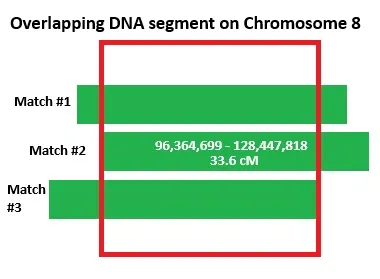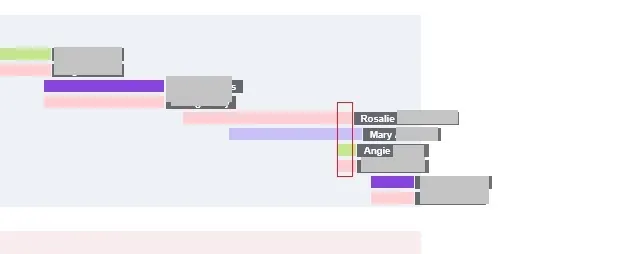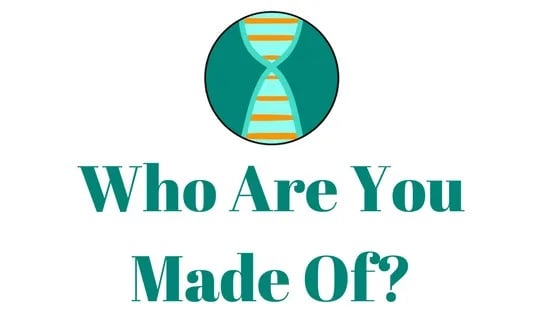Do you have two or more DNA matches that share an overlapping DNA segment? In this post, learn what this means and how to use this information.

If you are thinking about DNA segment overlap, but have questions, you are no longer a beginning DNA researcher. You know that there is more to get from your DNA results than just a list of people who may be related to you in some way.
The great news is that you are right. Learning about when DNA segment overlap is significant, and how to use this information through a technique called triangulation can open up new pathways for you to learn even more about your ancestors.
Below, we will jump right in to learning what segment overlap is, when it is triangulation (and when it isn't), and how to use this technique across different DNA testing platforms.
Towards the end of the post, you will find a real life examples of overlapping DNA segments.
Let's get started!
Triangulation vs simple overlap
Triangulation of DNA matches occurs when at least three people, the host DNA profile and at least two other DNA matches, share a DNA segment inherited from a common ancestor. The shared DNA segment must be located at the same location on the same chromosome across all members of the triangulation group.
Simple overlap is when DNA segments overlap, but there is no evidence of a shared ancestor within the pair or group of matches. There are several reasons why an unrelated group of people can have an overlapping DNA segment, including the segments being coincidentally identical (identical-by-state).
The image below is an example of a DNA segment shared with three different matches at the same location on Chromosome 8. If we don't know if all of these people share a DNA segment because they inherited it from a common ancestor, then we would call this simple overlap.

However, if we know, or strongly suspect, that everyone in the group of matches did inherit the DNA segment from a common ancestor, we would call the DNA segment an identical-by-descent (IBD) segment. We would also then be able to say that we have triangulated the DNA segment.
You will note in the image that each DNA match shares a segment that begins and ends at a different location on the chromosome.
For our research purposes, we would only count the area in the red triangle, which is the area that is overlapped by all members of the triangulation group, as the triangulated segment.
When triangulation is meaningful - the elements of a triangulated DNA segment
In order for a triangulated DNA segment to be meaningful, and useful for family tree research, we need our DNA segment and triangulation group to have as many of the elements below as possible.
Three or more people are in the triangulation group
Your triangulated segment should be shared with at least three people. You count, so you just need two additional people in the group.
Everyone in the group is probably descended from the same common ancestor
Usually we start working on a triangulation group because we suspect that all or most of the group is descended from the same common ancestor.
Sometimes triangulation is helpful when we think someone should be in a triangulation group (we might know for sure that other members of the group are descended from a specific ancestor), or when we think that everyone in the group is related, but the shared ancestor is unknown.
All members of the group share the same DNA segment
Of course, everyone in the group should share a DNA segment with everyone else in the group. Some of the DNA matches might share other segments with you or other members of the group, but the focus should be on the segment that everyone shares.
The DNA segments must overlap the same location on the same chromosome
The DNA segment shared across the members of the group should overlap at the same location on the same chromosome. It's okay if some of the DNA segments are also identical at locations before and after the triangulated segment.
At least 7 cMs in length, though the longer the better
Ideally, a triangulated DNA segment is at least 7 cMs (centimorgans) in length. Longer segments are better whenever possible, since small segments (like 7 cMs) have a higher chance of being identical-by-state (IBS) or from an ancestor who is too far back in your family tree to identify.
The DNA segments are from phased data
When possible, use DNA matches from phased DNA match lists. Phased DNA matches are DNA matches that either match your mother or your father, too.
Phased DNA matches are preferable for triangulation research because using these matches helps eliminate identical-by-state (IBS) segments, which are essentially false DNA matches.
How to use triangulation across different DNA testing platforms
Sometimes we don't have enough DNA matches on a single DNA testing site to make a group of matches. Or, we might have matches from multiple websites where we've tested our DNA who we think might be all descended from the same ancestor.
These are only some of the reasons that we might want to know how to get chromosome-level details about shared DNA segments across multiple DNA testing platforms.
Currently, there are only two major DNA testing sites that allow us access to chromosome-level data for our DNA matches, which is crucial for DNA segment triangulation. These two companies are MyHeritage and Family Tree DNA.
I've written posts about how to use the chromosome browsers on each of these websites:
Fortunately, if you did not test your DNA with either of these two companies, you can download your raw DNA data and upload it to Gedmatch, a website with free DNA research tools. One of the tools that Gedmatch users have access to is the One-to-One tool, which is essentially a chromosome browser.
Where to put the data once you get it
Once you have all of the data on the shared segments you would like to triangulate, you need a method of organizing your information. Some people use spreadsheets, but I prefer to use DNA Painter.
With DNA Painter, you can "paint" in any DNA segment by copying and pasting the shared DNA segment details that you locate on any of the testing platforms that you use.
Real example of a triangulated DNA segment
To illustrate one way that we can use triangulated DNA segments, I am sharing the story of a few 2nd-3rd cousins, Rosalie, Mary and Angie. When I saw Angie show up as a DNA match, I didn't know how she was related to me.
However, I had previously worked on a triangulation group of DNA matches that included myself, Rosalie, and Mary. I knew which ancestor that I shared in common with these two cousins, and so I could make the assumption that the DNA segment that we shared was inherited from that shared ancestor.
When Angie showed up as a DNA match, I asked her to upload her DNA to Gedmatch so we could compare segment data. When I pasted her segment data into DNA Painter, I saw that one of our shared segments overlapped with the triangulated segment that I shared with Rosalie and Mary.
The image below is from my DNA Painter profile where you will note the overlapping DNA segment shared between myself, Rosalie, Mary and Angie. The segment, which I have highlighted in a red rectangle, is about 7.6 cMs in length.

There were additional overlapping segments that included other members of the triangulation group, including one that you might have noticed from the image I shared. Angie is light green and Rosalie is pink, and they have another, larger overlapping segment on the same chromosome.
Once I had this information and a lot of evidence that Angie was likely descended from the ancestor that I shared with other members of this triangulation group, I was able to help Angie narrow her genealogy search. We were eventually able to find genealogical evidence of our relationship that solidified what we had discovered through DNA.
Conclusion
I hope that you enjoyed this post about overlapping DNA segments and when they mean that you have triangulation. In addition, I hope you have learned a little bit about how to use this technique in your own family history research.
If you have any questions about something that you read in this post today, or if you would like to ask a specific question about DNA segments that you believe might triangulate, I would love to hear from you in the discussion below.
Thanks for reading today!
